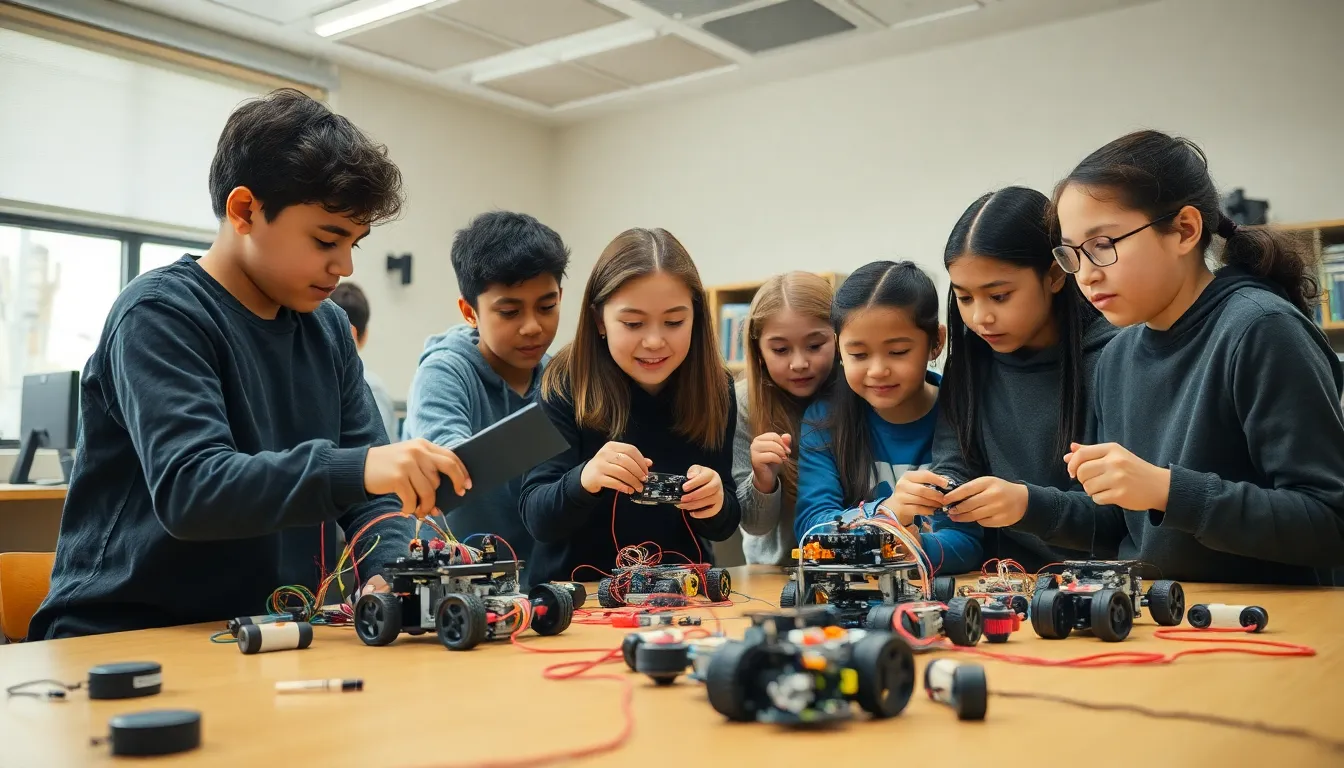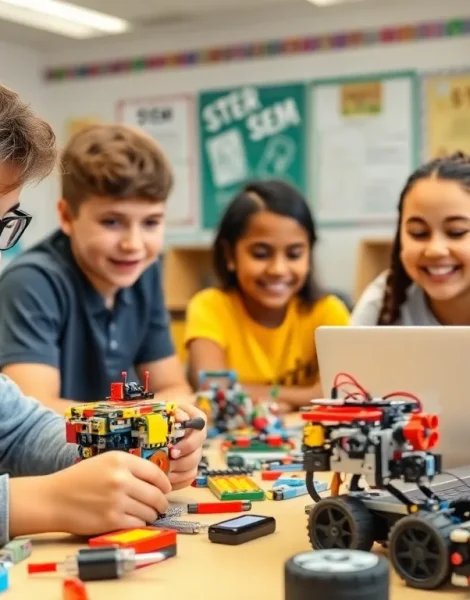In a world where robots are no longer just the stuff of sci-fi movies, classrooms are buzzing with excitement over robotics kits. These kits are more than just a box of parts; they’re the secret sauce to sparking creativity and problem-solving skills in students. Imagine kids building their own robots while learning coding, engineering, and teamwork—all without the risk of a robot uprising.
Robotics kits transform traditional learning into an engaging adventure, making STEM subjects as thrilling as a roller coaster ride. Whether it’s a simple robot that dances or a complex machine that can navigate mazes, these kits empower students to think critically and innovate. So why not swap out the dusty old textbooks for some hands-on fun? After all, who wouldn’t want to be the coolest teacher on the block with a classroom full of future engineers and tech wizards?
Table of Contents
ToggleOverview of Robotics Kits for Classrooms
Robotics kits for classrooms provide hands-on learning experiences that enhance students’ creativity and critical thinking. These kits often include components like motors, sensors, and controllers, allowing students to build and program their own devices. Engaging students in coding and engineering inspires collaboration and teamwork among peers, making the learning process dynamic and enjoyable.
Educational institutions increasingly adopt robotics kits to transform traditional instruction methods. Popular brands like LEGO Mindstorms and VEX Robotics offer versatile solutions suitable for varying age groups and skill levels. Vendors frequently update their kits with new technology, ensuring that the learning material stays relevant and aligned with industry trends.
Moreover, these kits often integrate well with school curricula, supporting subjects like mathematics and science. Instructors can use robotics projects to demonstrate real-world applications of theoretical concepts. Utilizing robotics kits also prepares students for future careers in technology, engineering, and mathematics fields.
Budget-friendly options are available to accommodate different classroom needs, ensuring accessibility for diverse educational settings. Workshops and extracurricular programs can further enhance the learning experience, providing students the opportunity to apply their skills in competitive environments. Experiences gained through these robotics kits not only boost academic performance but also equip students with essential life skills.
Benefits of Using Robotics Kits in Education

Robotics kits significantly enrich the learning experience in classrooms. They engage students in a hands-on way that promotes deeper understanding of complex concepts.
Enhancing STEM Skills
Robotics kits facilitate learning in science, technology, engineering, and mathematics. Students explore coding, circuitry, and mechanics through practical applications. Engaging with these subjects in a tangible manner encourages mastery. For instance, using motors and sensors helps students grasp fundamental engineering principles. Additionally, collaboration on robotics projects fosters teamwork as students tackle challenges together. Schools increasingly adopt these kits to stimulate interest in STEM fields, ultimately preparing students for future career opportunities.
Promoting Problem-Solving Abilities
Robotics kits challenge students to solve real-world problems through innovative thinking. Students encounter obstacles while building and programming their robots, prompting creative solutions. Encouraging iterative design processes helps develop resilience, as students learn from trial and error. Implementing solutions requires analytical skills, pushing students to evaluate outcomes carefully. Moreover, tackling these challenges fosters critical thinking, an essential skill in any discipline. The collaborative nature of robotics projects allows for diverse perspectives, enhancing problem-solving capabilities further.
Top Robotics Kits for Classrooms
Robotics kits provide unique opportunities for hands-on learning in classrooms. Below are three top kits that enhance student engagement and foster STEM skills.
Kit 1: Features and Benefits
LEGO Mindstorms offers a versatile kit ideal for students aged 10 and up. The kit includes motors, sensors, and programmable elements, promoting creativity through building and coding. Engaging projects allow students to construct various robotic designs, enhancing problem-solving skills. Collaboration encourages teamwork as students tackle challenges together. Adaptable curriculum resources align with educational standards, ensuring effective integration into classroom settings.
Kit 2: Features and Benefits
VEX Robotics expands learning opportunities for students from middle school to high school. This kit features robust materials like metal frame pieces and various sensors, enabling versatile robot designs. A user-friendly programming interface allows students to turn ideas into code easily. Students develop critical thinking and engineering skills through competition and collaboration. Additionally, the kit’s integration into STEM curricula supports complex project-based learning experiences.
Kit 3: Features and Benefits
Sphero SPRK+ serves as an innovative choice for younger learners. This spherical robot encourages coding through a mobile app and Bluetooth connectivity. Brightly colored designs attract students’ attention while engaging them in lessons about programming and robotics. Interactive activities stimulate creativity, making abstract concepts tangible. By participating in hands-on challenges, students sharpen their problem-solving abilities and learn foundational STEM principles effectively.
Implementation in the Classroom
Effective implementation of robotics kits in education involves several key elements that enhance student experience and learning outcomes.
Teacher Training and Resources
Training teachers stands as a vital initial step. Familiarity with robotics kits allows educators to guide students effectively. Many organizations offer professional development workshops tailored for robotics education. Utilizing online resources, such as tutorials and instructional videos, helps teachers integrate robotics into their lessons smoothly. Consequently, having access to lesson plans and project ideas enhances class engagement. Educational forums and communities also provide platforms for teachers to share experiences and strategies, boosting confidence in utilizing these tools. Continuous learning through these resources ensures teachers remain informed about the latest robotics advancements, enriching the classroom environment.
Classroom Management Tips
Managing a classroom with robotics kits introduces unique challenges. Establishing clear guidelines helps maintain focus during projects. Setting up designated workstations for each kit fosters organization. Encouraging teamwork promotes collaboration and accountability among students. Utilizing timed activities can further engage students while keeping them on task. Regular check-ins allow teachers to offer support and address challenges early. Emphasizing respect for equipment helps maintain resources in good condition. Implementing group roles, such as project manager or lead coder, can clarify responsibilities and promote effective communication. These management strategies enhance the overall learning experience while fostering an enthusiastic classroom atmosphere.
Robotics kits are revolutionizing the classroom experience by making learning interactive and enjoyable. They empower students to explore complex concepts through hands-on activities and collaborative projects. As education continues to evolve, these kits will play a crucial role in preparing students for future challenges in STEM fields.
By integrating robotics into the curriculum, educators can foster a generation of innovative thinkers and problem solvers. The accessibility of various robotics kits ensures that all students, regardless of their background, can participate in this exciting learning journey. As schools embrace these tools, the potential for creativity and discovery in education will only continue to grow.








